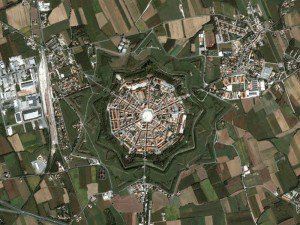Share This
Related Posts
Tags
Purpose Cities
By Erica Rascón on Sep 10, 2014 in News
What sets the blossoming Adelaide, Australia apart from the confines of Palmanova, Italy? It’s a question that many city designers face with a mix of fear and excitement. And with more purpose cities on the horizon, it’s a question better answered sooner than later. City planners may find the answers by taking a look into multifamily developments.

Palmanova from the air. Image via Google/Digital Globe.
Purpose-built cities, or planned cities, are cities constructed from the ground up to fulfill a distinct need. In the case of Brasilia, Brazil, planners selected the location to avoid maritime raids of the early 19th century. El Salvador, Chile, was built as a self-sustaining center for miners.
Today’s purpose cities are more of a novelty in comparison. Designers envision futuristic utopias that provide a haven from carbon-riddled metropolises. Purpose cities and smart cities often merge, touting automated infrastructure and an inclination towards sustainability.
Well organized, sustainable, with that new city scent—why aren’t the new purpose cities more popular? Why aren’t cities like Songdo and Lavasa bursting at the seams? Most planned cities are placed in uncharted territory, an effort to transform a desert into an oasis or a pristine wilderness into tame city streets. Far commutes from “civilization” don’t appeal to those who like to stay in touch with family and friends. Remote locations are also a tough sell for businesses, a headache for transportation coordinators, and a gamble for hospitality and entertainment leaders.
Building on pristine, undeveloped lands certainly doesn’t bode well for environmentalists. Sustainability and sprawl are incongruent at best. A more suitable approach has been to build on reclaimed land or retrofit existing cities. Amsterdam 2.0 leads Europe in smart city retrofits and redesigns. Santiago is also etching its name of the world’s list of tech-savvy, earth-friendly existing cities.
Of equal importance, all purpose cities lack the human element, the organic spark that makes cities alluring. Cities built uniformly from the ground up don’t have the charm that comes with history: varied architecture, historic landmarks, and generations of families and businesses that make a place feel like “home,” even to newcomers. When a city planner dictates the hip hangout spots in the city, those spots are no longer hip places to hang out. Hipness seems intrinsically tied (at least at first) to the idea of overlooked jewels, not well-marketed campaigns.
Yet in spite of their flaws, purpose cities are still popping up around the globe. Masdar City in Abu Dhabi promises to be a marvel with state-of-the-art, energy efficiency everything. There are even plans for personalized air travel. A few seas over, PlanIt Valley teases the Portuguese with hopes of a fully-automated city. Data sensors throughout town will send information back to central command and out to utility suppliers, emergency response teams, and residences.
Purpose-built, smart cities are still in the making because designers are inching closer to what will work. In this industry, we’ve known what works for quite some time. There are a few characteristics that have repeatedly drawn success. Whether these characteristics are applied on a small scale, such as a multifamily property, or the large scale of a city, they appeal to the buyers of tomorrow:
- Maximizing resource efficiency, saving money and minimizing ecological devastation in the future
- Elimination of excess, wasted space
- Inclusion features such as accessibility and affordability
- Working with the environment rather than aiming to conquer it
- Leaving room for growth at the hands of residents
- Balancing privacy and security
The least successful purpose cities lack more than one of these characteristics. Fulfilling all six of these points is certainly a tall order but with people-centered planning, anything is possible.
